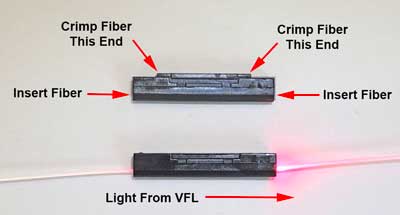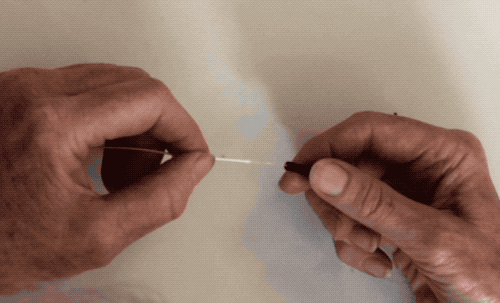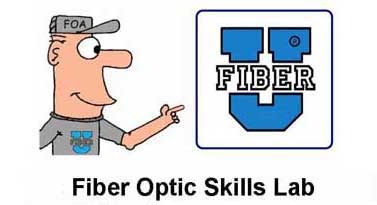Lesson:
Splicing Optical Fiber With A Mechanical Splice
Objectives:
From this lesson you should learn:
How to use these tools to strip cable to the bare fiber
Tools:
Safety Glasses
Fiber Stripper
Kevlar Shears
Fiber Cleaver

Components:
Fiber optic cable
Splices (several for practice)

Safety:
 |
Always
wear safety glasses when doing any of
these exercises and dispose of all fiber
scraps properly.
Safety
Rules - Read before beginning any
exercises.
|
Exercise
Before attempting this exercise, you should complete
the exercises on stripping
and cleaving
fibers.
1: Examine the mechanical splice. The splice has a
sleeve inside that aligns the fibers to create a splice.
The installation process involves preparing a fiber,
inserting the fiber in the splice, crimping that end,
then preparing a second fiber, inserting it until it
butts up against the first fiber to create a splice,
then crimping the second fiber. Finish
the splice by pushing the crimp section down fully.
A VFL can be used to verify the splicing process as you
can see below. Insert the connector of your cut
patchcord in the VFL and turn the VFL on. The light from
the end of the fiber will help you see the small hole on
the end of the splice where you must insert the fiber
and it will help you verify the splice has been made
properly.

We'll use this mechanical splice to splice two pieces
of your cable back together in this exercise.
2. Use the fiber stripper to cut off 4" (100mm) of the
cable jacket and pull off the cut piece.
3. Use the kevlar scissors to cut the aramid fibers at the
end of the jacket, exposing the 900micron tight buffered
fiber.
4. Use the fiber strippers to strip ~1.5" (40mm) from the
end of the fiber in 4-6 steps, about 1/4-3/8" (6-8mm) at a
time.
5.
Clean the fiber with a lint-free wipe and alcohol.

6. Cleave the fiber to a length of 15mm from the end
of the 900 micron buffer using the cleaver's stripping
gage.
Clean
up all your fiber scraps immediately after cleaving
the fiber and dispose of them in a container like a
used take-out coffee cup marked "Fiber Scraps"!
7. Insert the fiber into one end of the splice until it
stops, then push down the plastic crimp on the end to hold
that fiber. Be sure to only push the crimp at the very
end so you do not crimp both ends - that will make it
impossible to insert the second fiber.
8. Repeat with the second fiber - strip/clean/cleave -
then insert the fiber in the other end of the splice.
Watch the VFL light to see how the light increases out of
the fiber as the splice joint is made. When you get the
brightest light, crimp the second fiber, then push the
crimp down fully.
Watch this to
see how it's done:

9.
Practice this exercise several times with the splices
supplied. Be sure to keep several splices if you need to
do demonstrations to your instructor.
You have successfully completed this exercise
when you have made several splices that show low
splice loss and good light through the splice.
After
successfully splicing fiber several times, fill in your
Scorecard.
Learn the "splicers mantra" - "strip - clean -
cleave - splice"
Return
to Lesson Plan
This information is
provided by The Fiber Optic Association, Inc. as a
benefit to those interested in teaching, designing,
manufacturing, selling, installing or using fiber optic
communications systems or networks. It is intended to be
used as an overview and/or basic guidelines and in no
way should be considered to be complete or
comprehensive. These guidelines are strictly the opinion
of the FOA and the reader is expected to use them as a
basis for learning, as a reference and for creating
their own documentation, project specifications, etc.
Those working with fiber optics in the classroom,
laboratory or field should follow all safety rules
carefully. The FOA assumes no liability for the use of
any of this material.
|

